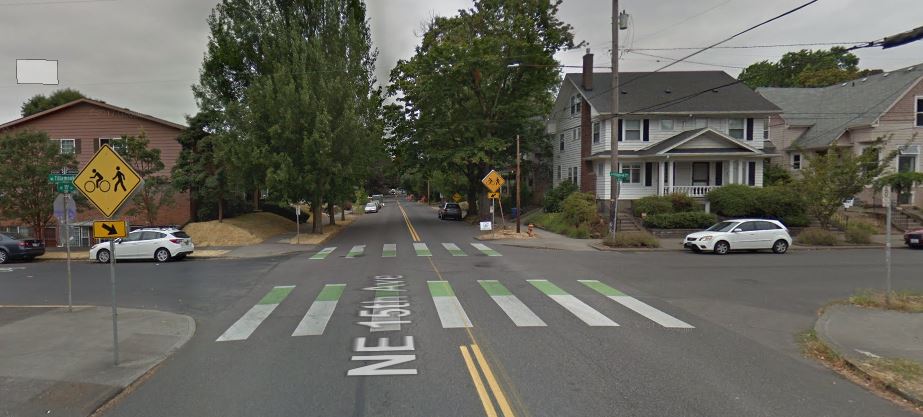Portland’s inner eastside contains an extensive network of neighborhood greenways: low traffic side streets that encourage bike traffic by including sharrow pavement markings, bike-specific wayfinding signs, speed bumps, diverters, and fewer stop signs. Examples include NE Going, NE Tillamook, SE Clinton and SE Lincoln. While greenway riding is typically a low key alternative to riding in a bike lane or on the shoulder of high-volume, auto-oriented streets, the crossing of higher speed arterials that cross the greenway can be stressful. At most greenway crossings of arterials, bicyclists face a stop sign and cross traffic flows freely. In an effort to improve arterial crossings, the City has painted green “crossbikes” across the intersection and installed signs warning arterial drivers of the greenway crossing. The NE Tillamook greenway crossing of NE 15th Avenue is shown here:

What, if any, legal authority do these green “crossbikes” confer on greenway bike users? The short answer: none. Despite the similarity in appearance and name to “crosswalk”, a crossbike does not entitle a bicyclist to any of the legal rights enjoyed by a crosswalk user.
Crossbikes do not fall under the legal definition of a crosswalk. A marked crosswalk is defined under ORS 801.220 as “any portion of a roadway at an intersection or elsewhere that is distinctly indicated for pedestrian crossing by lines or other markings on the surface of the roadway.” While crossbikes do constitute roadway markings at an intersection, their location in the roadway demonstrates that they are not intended for “pedestrian crossing.” Therefore, crossbikes are not crosswalks, and crossbike users are not entitled to any of the legal rights of crosswalk users. In fact, crossbikes fail to fall within any statutory definition under Oregon law, making them legally meaningless.
Despite their lack of legal meaning, drivers and bicyclists often treat crossbikes as if they were—as their name suggests—crosswalks for bikes. Under Oregon’s crosswalk law, ORS 811.028, once a pedestrian begins crossing in a crosswalk, approaching drivers must stop and remain stopped until the pedestrian has cleared. Pedestrians can assert this right of way by moving into the roadway with the intent to proceed. Therefore, pedestrians using the white zebra-striped crosswalks in the above photo have the legal right to cause cross traffic to stop simply by stepping into the roadway.
In contrast, bicycle users of the green zebra-striped crossbikes in the above photo have no right to cause cross traffic to stop. Instead, pursuant to ORS 811.260(15), the stop sign they face requires them to stop and yield to cross traffic. However, the similar appearance of the two types of markings, together with the yellow signs indicating bicycle and pedestrian crossing, strongly suggests that arterial traffic must yield to all greenway users. Indeed, the behavior of many arterial drivers and greenway bicyclists demonstrates that, despite the underlying legal rights, crossbikes largely function as crosswalks for practical purposes.
Is there any harm in this inconsistency between the practical use of infrastructure and the underlying legal authority? In many cases, perhaps not. While installing crossbikes didn’t cost the City much (the green paint and signs were presumably relatively inexpensive) and the legal ambiguity may help bicyclists cross arterials more efficiently, there may be higher costs. For example, what if a bicyclist mistakenly assumes that an approaching vehicle is slowing, and rolls past the stop sign into the crossbike? Under Oregon law, the driver would clearly have the right of way, and the result could be a seriously injured bicyclist with no legal recourse because the cyclist was not entitled to the right of way.
